26-knotters class destroyers (A Class)
 United Kingdom (1892-1912)
United Kingdom (1892-1912)
Destroyers HMS Havock, Hornet, Daring, Decoy, ferret, Lynx.
WW1 British Destroyers:
26 knotters | 27 knotters | 30 knotters | 33 knotters | Turbine destroyers | River class | Cricket class | Tribal class | Beagle class | Acorn class | Acheron class | Acasta class | L class | M class | Repeat M class | Medea class | Faulknor class FL | Marksman class FL | Parker class FL | Talisman class | Shakespeare class FL | R class | S class | Repeat R class | V class FL | Scott class FL | V class | W classThe lineage of British Destroyers started with the experimental “26-knotters” in 1892 when Yarrow, Thornycroft and Laird were ordered ships tailored to hunt down torpedo boats.
First envisioned by the Admiralty in 1891, they were ordered on the 1892–1893 naval programmes. Certainly the oldest destroyers in service with the Royal Navy in 1912 when the last were discarded, they were relatively small ships, barely able to sustain long cruises by bad weather. Not even intended for operational role, they were ordered as prototypes, spread between three yards and in a sense a preserie for the next 36 “27 knotters” ordered from many more yards. Retrospectively in 1913, both the 26-knotters, and 27-knotters were called collectively the “A” class.
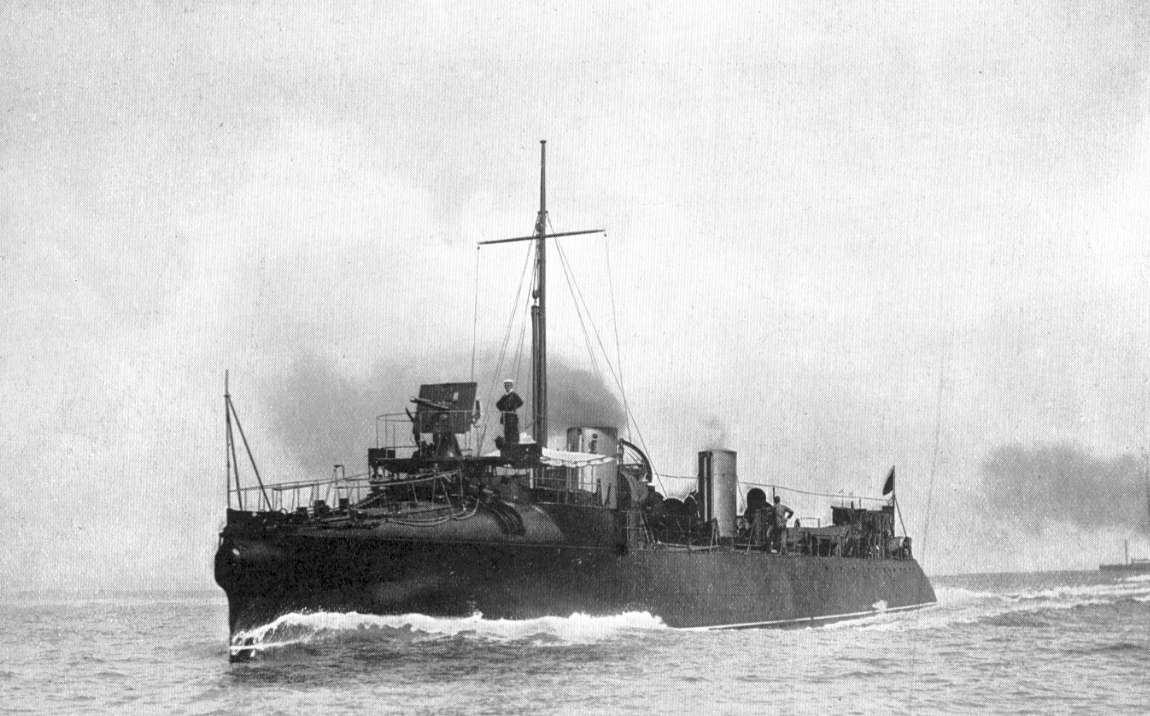
HMS Daring, 26-knotters of the Thornycoft order. At that time these ships had a black hull and sand colour superstructures.
Origins: The destroyer programme
The Torpedo Gunboats
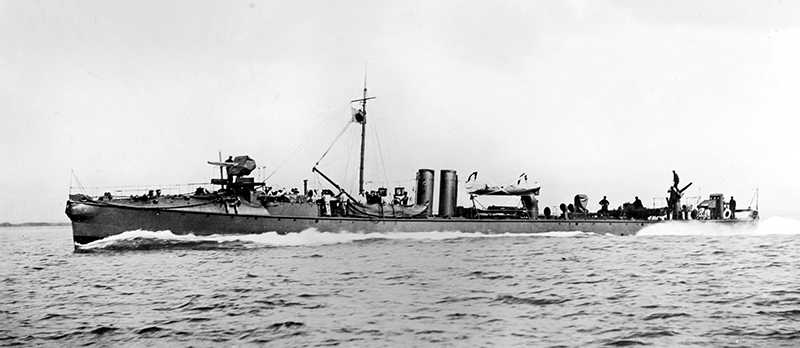
The origin of the “destroyer” (other nations has different names for these, like France with the “Contre-Torpilleur”, Italy with the “cacciatorpediniere” or Germany with the “Hochseetorpedoboote”). The first true “destroyer” however is not perfectmy sure to pinpoint. Most authors agrees with the “Spanish Connection” however. In the 1880s, there was a short-lived ship type which could have played a role in torpedo-boat hunting. These were called the “torpedo-cruisers”, a fad that lasted roughly from the mid-1880s to the mid-1890s and centered around this new, yet to be refined “mobile mine”, the torpedo. In British service, they were the RATTLESNAKE (1887), GRASSHOPPER class (1888), SHARPSHOOTER class (13, 1889-1892), ALARM class (11, 1893-1894) and DRYAD class (5, 1894-1895) already designed as “torpedo boat killers”. Why this lineage was ended ? They were too slow to cacth TBs, and too costly when a larger torpedo boat could on paper do the same job, faster.
The Torpedo Boat
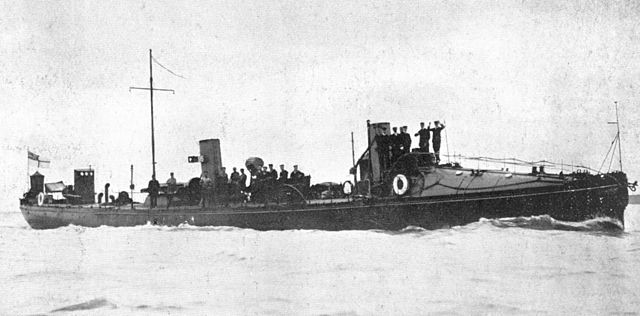
As for the torpedo, it was born in the Adriatic, at Whitehead’s office in Fiume from a Serbian invention of the 1860s, later refined in the 1870s and eventually marketed, the torpedo gradually ended on all ships types on order, as the new “wonder weapon” that can sink a ship by itself in a more proactive way than a mine.
Some navies were keen on capitalizing on this new weapon, and in various nations, as soon as these devices were purchased, a consensus was gradually established about how best way to deliver them: As a small and light weapon any small steam cutter could carry them. Thus, based on previous spar torpedo ships that existed from the American civil War (1861-65) to the mid-1870s, some thought about adapting fast steamers to deliver the new weapon in the same way.
In fact any onboard steamboat of a battleship could in theory do the job. The concept of mothership was tried by most nations, in a more or less cautious or experimental way, until establishing the inanity of the concept of “midget torpedo boat”.
The development of torpedo boats started in France after the war of 1870, which triggered immense doctrinal changes (priority to the army, the navy is reduced and focus on new technologies) and in Great Britain, in order to at least test the concept. See the British torpedo boats page for more. In britain, the lineage started in 1879, and first series were delivered by various yards, later also involved in building the first destroyers.
In the 1880s so, most fleets had torpedo boats in their inventory. This new ship type was seen by some as “disloyal” and for others as a “great equalizer”, enabling to reduce fleet disparity before a more conventional, “Mahanian”, clash could take place.
By 1891, it was clear already that Torpedo Gunboats had their limits given the latest machinery innovations and speed of the new torpedo boats, and the surest way to intercept and destroy a torpedo boat… was another one. Albeit gun-armed. Indeed, already on paper, fast torpedo boats posed a real threat to battleships, overwhelming her close defences or distract her, making her dodging torpedoes instead of presenting a broadside, and thus making her more vulnerable to opposing capital ships.
Wake up call and 1891 order
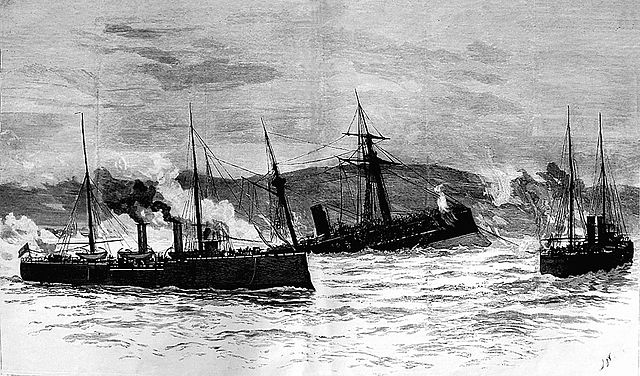
But moreover, torpedo boats proved devastatingly effective in the 1891 Chilean Civil War. Indeed in the Battle of Caldera Bay, Loyalist flagship armored frigate Blanco Encalada was sunk by the Balmaceda Faction’s, Almirante Lynch, a torpedo gunboat. This was a wakeup call for all admiralties about the torpedo, still largely unproven at that time.
Already the 1886 British-built Destructor for the Spanish Navy was designed as “torpedo boat hunter” and had some in the RN interested in the new concept. Sir William Henry White, which designed her, was appealed as the lack of reaction of the RN for such concept. He knew the admiralty was worried about TBs but most still relied on the torpedo gunboat concept. However many realized they lacked the range and speed to keep up with the fleet they were supposed to protect…
 Enters Sir Jackie Fisher (again!) at the time Third Sea Lord and Rear Admiral, he was perfectly aware of torpedo “catchers”, “interceptors” “hunters” concept looked after in other nations, but often doubling simply as larger sea going TBs. This included France which built massive fleets of Torpedo Boats and sea going TBs in 1886 to lead or catch enemy TBs if needed. France’s first true “contre-torpilleurs” were ordered in fact much later in 1898. Germany soon stuck with the “hochseetorpedoboote” up towards the end of WW1. Italy introduced the concept of Cacciatorpediniere also a bit later in 1896.
Enters Sir Jackie Fisher (again!) at the time Third Sea Lord and Rear Admiral, he was perfectly aware of torpedo “catchers”, “interceptors” “hunters” concept looked after in other nations, but often doubling simply as larger sea going TBs. This included France which built massive fleets of Torpedo Boats and sea going TBs in 1886 to lead or catch enemy TBs if needed. France’s first true “contre-torpilleurs” were ordered in fact much later in 1898. Germany soon stuck with the “hochseetorpedoboote” up towards the end of WW1. Italy introduced the concept of Cacciatorpediniere also a bit later in 1896.
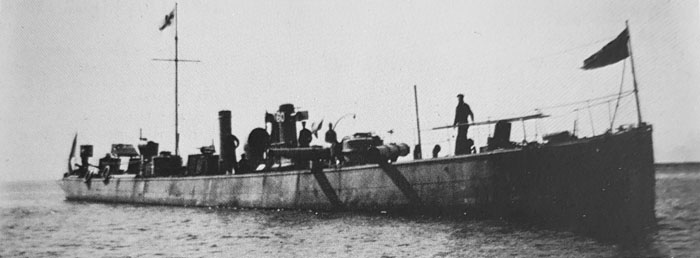
Thornycroft’s contemporary 140 footer TB, the “prey”.
So Britain was an early bird in this game eventually, under the impulsion of the impulsive Fisher, which argued that this experiment would not be that costly compared to a new battleship or even cruiser, and the full technical support of Yarrow, eventually managed to have ordered three pairs of TBs as experimental measure, seen by some as a long overdue in 1892. News from Chile helped him to sell the idea to the admiralty.
The start of a lineage

Model of HMS Hornet. Note the slightly flared bow, turtleback forecastle, rounded stern, large leaf-style rudder. Technically the steering wheel was located both in the conning tower, below the fore gun platform, and aft, close to the stern. The low-mounted CT offered some protection agains splinters but also a lot of sea spray by heavy weather as the ships ploughed heavily. Note also the projector af for night operations. The four guns (later five) were fast-firing and could deliver quite a punch (see later).
The 1880s had seen several attempts to produce an effective counter to the torpedo boat by enlarging it and giving it more guns, the “125-footers” and HMS Swift (TB 81) being cases in point, and the term ‘torpedo boat destroyer’ had already been used for some of these types. The Germans’s “Division Boats”, though admittedly not for anti-torpedo boat work and without a strengthened gun armament had been watched closely also. Leading torpedo boat firms (with both Thornycroft and Yarrow to the fore) had been producing designs for destroyer-type vessels for some years before the first destroyers were ordered officially by the Admiralty.
The catalysts which produced the first order for the new type were the combination of the fear of the increasing number of new, large and fast torpedo boats being built by the French, the continuing insufficiency of the torpedo gunboat designs, and the presence of a dynamic Controller in Fisher, backed by an equally active and powerful Board of Admiralty. Fisher consulted with both the leading torpedo boat special lists (it is worth noting that Thornycroft actually obtained their order for destroyers a couple of days before Yarrow) and several other builders were given an opportunity to tender for vessels of 200 or 300 tons, capable of 27kts . (Thornycroft actually offered 28kts for their larger design.) Eventually the Board decided on the smaller design, but with the armament of the larger one, which resulted in some increase in dimensions and tonnage in the designs which were built.
From the start, though the primary purpose was to sink torpedo boats, the possibility of using the new vessels to replace TBs for torpedo attack was borne in mind. The earliest destroyers had alternative armaments for one purpose or the other, but their immediate successors had a single outfit which combined the two. As the faster, more powerful and more seaworthy destroyer rendered the torpedo boat virtually obsolescent, it took over the rôle of the smaller vessel. Inevitably the destroyers themselves increased in size as time went on, and the need for, in the first instance, more speed, and, later, greater seaworthiness, influenced new designs. By the end of our period, with the “River” class , the torpedo boat destroyer, which was only a slightly larger torpedo boat, had changed into the true destroyer, a very different sort of vessel and one which fitted the 1870s conception of a purpose-designed seagoing torpedo vessel.
Most reference works split early British destroyers into ‘A’, ‘B’, ‘C’ and ‘D’ classes, but it was a classification adopted for ease of recognition in September 1913, and is of little use in giving a historical account of the development of the destroyer. The ‘A’ class were the ’27-knotters’ (the “26-knotters being their preserie), the ‘B’ , ‘C’ and ‘D’ classes corresponding to the ’30-notters’ with, respectively, four (or more), three or two funnels. The diversity is in fact far greater, as each builder produced his own design , within certain broad outlines set by the Admiralty, and then usually built slightly modified versions…
This had two main advantages:
-Testing and comparing various Yard designs, for in case of war, larger series being ordered to the best.
-This enabled still to have numerous, relatively homogeneous boats quickly and place them in squadrons for useful service.
The only understandable backdrop being training (machinery crews especially) due to this lack of standards, maintenance and supply in some way. They still at the end had the same armament and speed.
Design of the 26-knotters
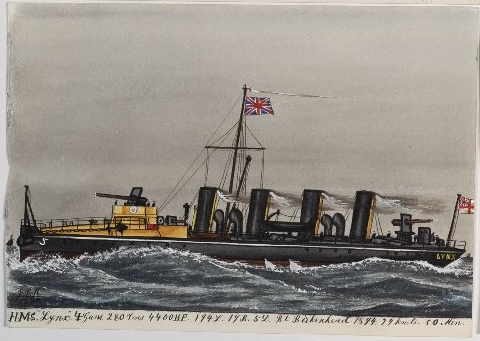
Depiction of the HMS Lynx in 1894 by painter James Scott Maxwell.
The order being placed on 27 June 1892 asked for two designs based on similar specifications. One to Yarrow (or course) and one to Thornycroft, the other great specialist of fast boats and instrumental in TBs development. This was hoped to produce comparable test boats as each yard was free to come with its own machinery solution (which was the main stringent specification here): They needed to at least reach 26 knots on trials and maintain it as a practicable top speed. For the remainder of the specifications, Fisher and Yarrow, which was closely associated in the concept, just asked for an engarged torpedo boat, better armed and if possible faster. Contemporary TBs of the RN indeed just ordered the same year in 1892 were the “140 footer” serie. Note the class designation here, speed for TBDs, size for TBs.
The Yarrow’s 140 footers were 105 tons ships capable of 23.5 knots and armed with three 3-pdrs and three TTs. The corresponding TBDs (the RN adopted the term “destroyer” perhaps in reference to the 1886 Spanish ship) needed to be at least three knots faster, and far better armed, with a single 12-pdr and six 6-pdr, but still retaining three TTs to act themselves as TBs. Overall, they had to be provided with the novel water-tube boilers and quick-firing small calibre guns to make the difference.
In 1893 (date unknown) was ordered a follow-up serie, this time to Laird, a strange choice as it was not a specialist, it had been building TBs as well, and met success with its own design, so it was chosen for a follow-up order, on the same specification, and again, a pair of ship with some leeway to test variants between the two.
It should be noted that the term “26 knotters” did not existed in the specifications or anywhere at the time. It was later brought back in a way of convencience to describe this serie compared to the “27”, “30”, and “33” knotters in the following years.
All differed according to their manufacturer and their displacement ranged from 275 to 280 tonnes fully loaded for 56-60 meters long. Their engine power also varied greatly, from 4,000 to 4,700 HP. Their shape also, according to their arrangements of machines and artillery. At the time they ran on triple-expansion machines and could reach a bit more than 27 knots, despite being classed as “26-knotters” which was more a convenience based on the programme year and the Yarrow boats, effectively capable of 26 knots.
Hull and general design

Plan of HMS Havock
The six ships group was consistent in specifications, but all diverged depending of their construction yard.
As for their displacement (see the specs), they were comprised between 240 and 300 tonnes standard, with the Yarrow boats being the heaviest at 350 tonnes fully loaded. The Yarrow and Thornycroft boats share the same hull lenght, but the former were beamer at feets (5.94 meters versus 5.67). The Laird boats were noticeably longer at 196 ft (60 meters) versus 183 ft (56 meters). They were also a bit beamier at 19 ft (6 meters)
Powerplant
All had to shaft propellers. The Yarrow boats diverged between themeslves. As the small tubes boilers were complicated to setup, the prototype HMS Havock was given a four-cylinder Vertical Triple Expansion stea engine (VTE) fed by two heavy locomotive fire-tube boilers, already proven. However HMS Hornet which was completed later has the same VTE but fed by eight Yarrow water-tube boilers. Later Havock was retrofitted with the same boilers. In case you wonder, eight boilers is A LOT for a torpedo boat sized ship. They occupied a good 1/4 of the hull, mounted at the very center, and were caracterized by two narrowly placed funnels in the center, as both loco boilers were turned head to head, fed by the back. This enabled to have a good weight repartition in the ship as again, they were pretty heavy compared to marine boilers. Later as reboilered she ended with three funnels. Her sister Hornet had four.
The Thornycroft boats were the most unique in the bunch, with just two short, widely spaced funnels. They had two 4-cyl VTE engines like the first serie, but fed by three Thornycroft boilers for an output of 4,200 shp, more than the 3,500-3,700 of the Yarrow boats. They looked also better built, more stocky and taller.
The Laird boats were both four-funneled like HMS Hornet, with three-cylinder VTE engines fed by four French-type Normand small tubes boilers, and were the most powerful of the group at 4,475 shp. However speed wise, the latter the were also the fastest, at 27.2 knots (50.3 kph, 31 mph), and going back to the first serie, 27 and 26 knots respectively. So technically speaking only the Havock class was a “26-knotter”. The latter designation was made based on the initial order, and kept by convenience.
They also carried 45 to 58 tonnes of coal (in order) for an autonomy ranging from 865 (Thornycroft boats) to 1,195 nm for the first serie.
Armament
It was the same for all boats as asked for by the admiralty: Three torpedo tubes, including one fixed in the bow like torpedo boats, but a considerable artillery: One 12-pdr or 3-in gun and six 6-pdr guns, all rapid-fire to inflict maximum damage to torpedo boats. Their primary target at the time were French TBs, and the sea-going ones (the 24.5 kts Corsaire serie) were just armed by two 37 mm (1-pdr) guns. The smaller coastal ones of the ‘126’ type were armed the same. After their rearmament, they lost their TTs, gained two more at five 57mm/40 6pdr Hotchkiss Mk I guns.
Main: QF 12-pounder 12 cwt naval gun
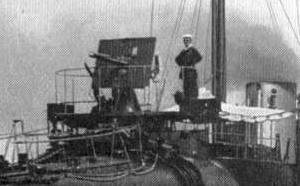 The QF 12-pounder 12 cwt naval gun was brand new when the new destroyers were in construction. It enterered service in 1894, as they were completing. This 0.6 tons (510 kg) ordnance made a superb career going up to 1945, with more than 8,000 delivered. It was also used by Italy and Japan and became the staple of light artillery on most RN ships, especially those of WW1. In the case of these destroyers, the Mark I was shielded and placed on the conning tower platform, high enough to avoid water spray. But in heavy weather, as the ship were ploughing deep due to their turtleback, they were wet anyway.
The QF 12-pounder 12 cwt naval gun was brand new when the new destroyers were in construction. It enterered service in 1894, as they were completing. This 0.6 tons (510 kg) ordnance made a superb career going up to 1945, with more than 8,000 delivered. It was also used by Italy and Japan and became the staple of light artillery on most RN ships, especially those of WW1. In the case of these destroyers, the Mark I was shielded and placed on the conning tower platform, high enough to avoid water spray. But in heavy weather, as the ship were ploughing deep due to their turtleback, they were wet anyway.
Specs:
It used a Separate-loading QF round, caliber 7.62 cm, with a single-motion screw breech.
Rate of fire was 15 rounds per minute, at 2,210 ft/s (670 m/s) for an effective range of 11,750 yd (10,740 m) at 40° for the latter version.
Secondary: 3-5 QF 6-pdr Hotchkiss
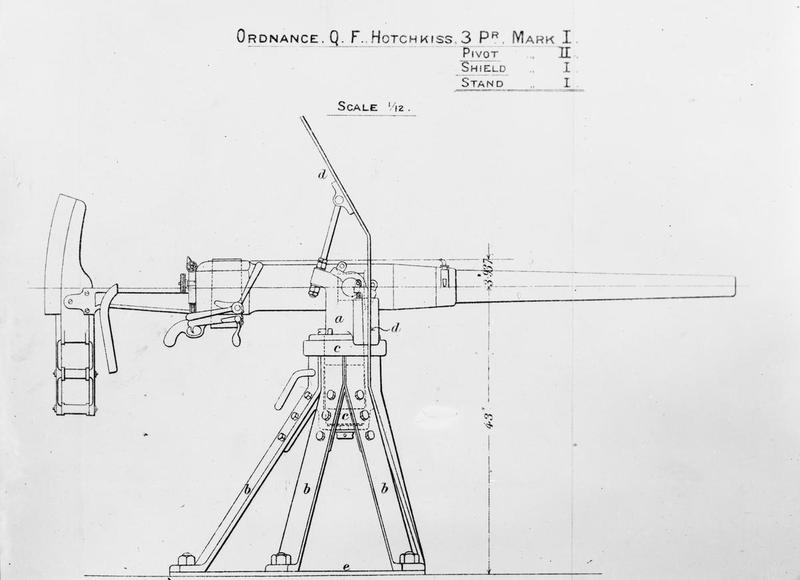
This “classic among classic” was developed in 1883 by Hotchkiss et Cie and a licenced was acquired by Elswick in Britain for mass manufacturing. It became the go-to light QF gun, still very much in favor by the 1890s. Weighting around 821–849 lb (372–385 kg) and shielded, the three guns were located forward for the first pair, abreast the main 12-pdr behind bulwark (but they were wet also) and the third was located on an axial platform aft, close to the stern.
Later in the early 1900s the side TTs were removed and replaced by two more, also shielded, placed on sponsoned platforms for a better arc of fire forward and aft.
Together with the 3-in gun (12 pdr) they could send 140 rounds every minute at the infortunate TB that could cross their path.
Specs:
57x307R 57-millimetre (2.244 in), Vertical sliding-block breech, 4 inch hydro-spring recoil
Rate of fire 25/minute at 1,818 feet per second (554 m/s), range 4,000 yards (3,700 m)
Torpedo Tubes
The Type used was likely the 18-inches Whitehead (45 cm) type, developed in 1888, and introduced as the 26-27 knotters were completed in 1894:
They weighted 845 lbs. (383 kg) for 140 in (3.556 m) in lenght, with an explosive charge of 118 lbs. (53.5 kg) using wet gun-cotton, single setting, 800 yards (730 m) at 26.5 knots (which was actually slower than the destroyer’s top speed!). It was driven by a three cylinder radial Brotherhood pattern engine, fed by an Air-flask (cold running) of compressed air.
No upgrade as they were ultimately all retired. Outside the bow tube, the two other ones were axial, located aft, often before the aftermost funnel and close to the aft steering post and before the stern gun. Six torpedoes were carried, the three already in the tubes, and three spares.
Evaluation & Succession
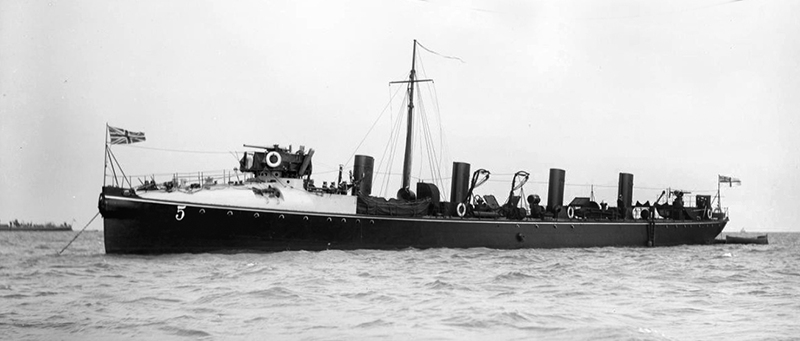
As the 26-knotters were built, the naval programme of 1893-94 saw further orders of a type defined also about the specified top speed of the time. More yards took part in it, namely in addition of the former, Doxford, Pamler, Earle, White, Donald & Wilson, Fairfield, Hawthorn Leslie, J&G Thomson, NCO, Armstrong, and Thames Iron Works. At 280 tonnes on average and without forecastle but a turtleback, they were just glorified torpedo boats. It would take the 30 and 33 knotters and prototype turbines destroyers for the concept to mature into the River class in 1903. For the ucoming months, this will a serie of articles looking at the early history of British destroyers leading up to the Great War. Apart nine exceptions, these 36 ships were discarded before the war.
 Havock class (Yarrow)
Havock class (Yarrow)
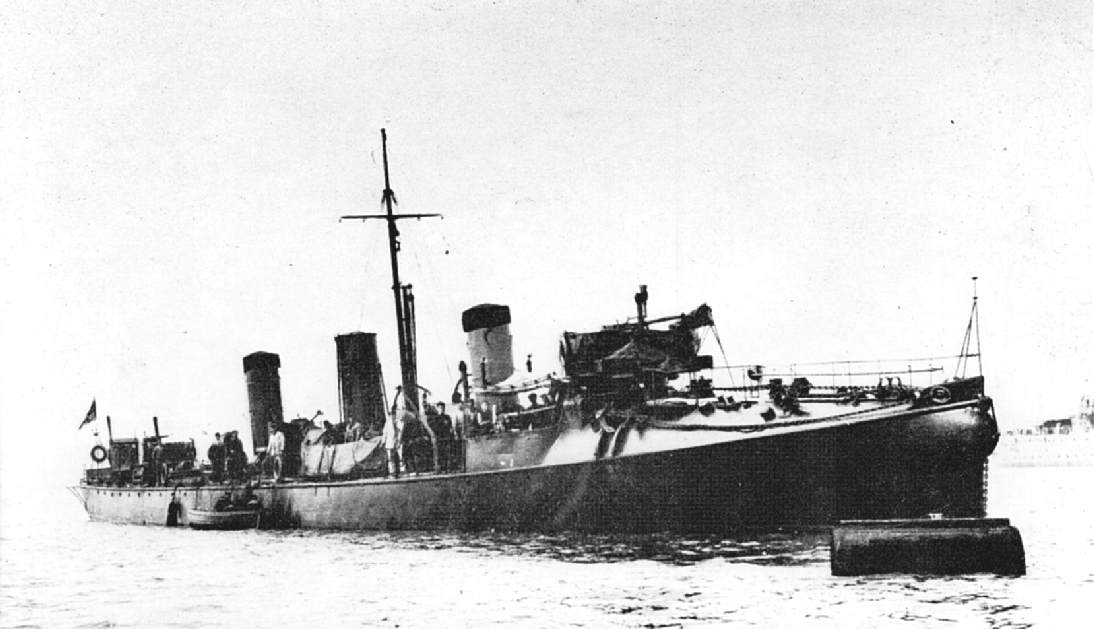
HMS Havock was laid down at Yarrow, Poplar on 7.1892, launched 12.8.1893 and comp. 1.1894. She became a despatch vessel in 1905.
HMS Hornet was laid down on 7.1892, launched 23.12.1893, comp. 7.1894 she also was reclassified as despatch vessel in 1905.
Havock “behaved well” on trials (late 1893) and she demonstrated better fuel efficiency than Hornet. By 1896 Havock was in reserve at Portsmouth and reboilered in 1899–1900. Her career was spent entirely around the British Isles under Lieutenant H. C. J. R. West from March 1902, and she served with the Medway Instructional Flotilla. By May 1902 her crew was transferred to the destroyer HMS Haughty and by 8 May she became a tender to Wildfire (shore establishment at Sheerness) but took part in 16 August 1902 Coronation Review for King Edward VII.
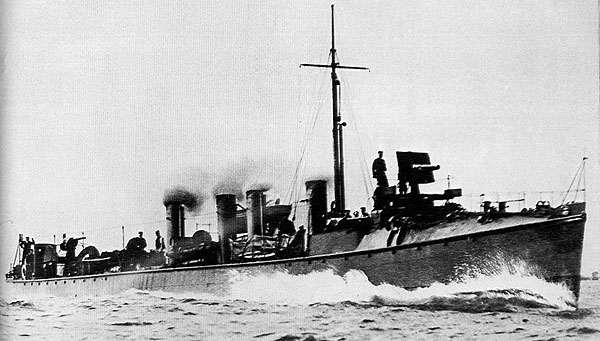
HMS Hornet in sea trials, 1893.
As for HMS Hornet her trials was generally successful but a slight vibration noted. She steering well and could reach an average top speed of 27.6 knots over three-hour. Like her sister she spent her career in Home waters, with a short assignation in the Mediterranean in 1900.
Her bow structure was strengthened in 1901 and the bow torpedo tube was removed for three reasons (this was done for all other 26-knotters):
The bow TT was found to be of little use
-It adversely affected seakeeping, restricted space forward
-The torpedo was actually slower than the ship, leading to the fear she could could over-run it at full speed.
In February 1902 she replaced HLS Zebra as tender to Wildfire, for the Sheerness Gunnery School. She also took part in the Coronation Review on 16 August 1902.
Displacement: 240t standard, 275t FL
Dimensions: 56.4m oa (54.9m pp), 5.67 x 2.21m
Powerplant: 2 shafts 4-cyl VTE, 2 locomotive fire-tube boilers (Hornet 2x 4-cyl VTE, 8 Yarrow water-tube boilers)
Performances: 3,700hp (Hornet) 3,500hp (Havock) 47t Fuel for Endurance 1,195 nm/11kts
Armament: 1x 76mm/40 12pdr 12cwt QF Mk I, 3 x 1 – 57/40 6pdr Hotchkiss Mk I, 1 – 450 TT (bow aw), 2 x 1 – 450 TT (6 at all)
Complement 46
 Daring class (Thornycroft)
Daring class (Thornycroft)
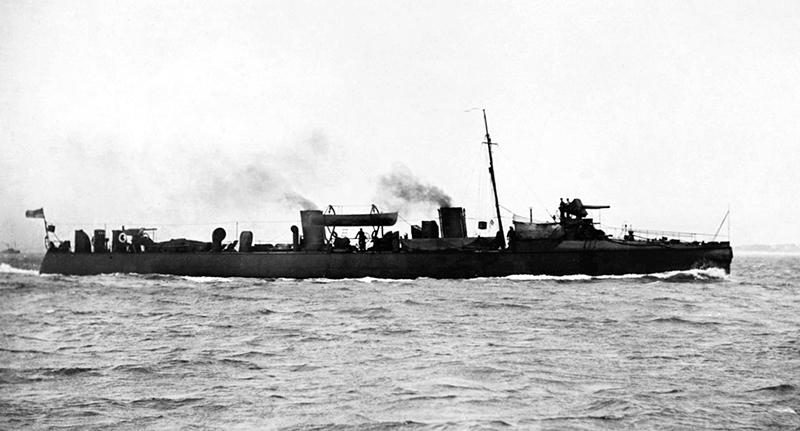
The first 5 destroyers were 26-knotters with an armament of 3-450mm TT (one fixed bow tube, two single deck tubes), and three QF guns. This was the armament carried, but provision was made for landing the two deck tubes and replacing them by an extra tow more 6-pdr if they were to be used entirely for anti-torpedo boat work. All these destroyers had twin shafts and triple expansion engines, though the Thornycroft boats had a special four cylinder triple expansion design.
Rather more strongly built than the Yarrow vessels, these two were also faster, though they took longer to build. Daring made nearly 28.2kts with 4644ihp on the measured mile. Like most subsequent Thornycroft destroyers they had two funnels (so that they would resemble torpedo boats) and flat sterns.
Both were built at Thornycroft, Chiswick.
HMS Daring was laid down on 7.1892, launched 25.11.1893, completed, 2.1895. She became a despatch vessel in 1905.
HMS Decoy was laid down on 7.1892, launched 2.2.1894 and completed, 6.1895, but was lost in collision on 13 August 1904

HMS Daring have served in home waters in 1895-1912. Commissioned at Portsmouth on 23 February 1900 as tender at the HMS Excellent gunnery school (Whale Island). By early June 1901 she suffered a boiler explosion at anchor (one death, 6 injured). The inquiry showed tubes blown out of the lower drum, puncturing and flooding. She was in the Fleet reserve and joined the instructional flotilla under Lt. A. S. Susmann from August. She was tender to gunnery school HMS Cambridge, Plymouth and by September was part of a squadron visiting Nauplia, Souda Bay, Crete. On 26 October 1907 she suffered a minor collision with HMS Starfish at Devonport.
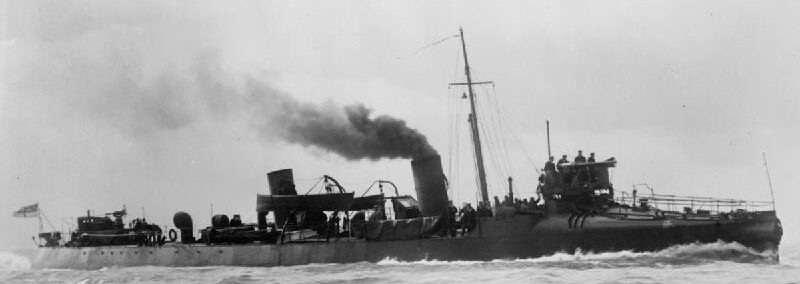
HMS Decoy took part in the 1896 British Naval Manoeuvres, Channel Fleet. She became an instructional tender to gunnery school Cambridge by August 1901. Lt. Cyril Asser was in command the next year, when part of the Devonport instructional flotilla, and later H. Ralph Heathcote in July, then J. I. Hammond on 8 August 1902. She took par tin the fleet review at Spithead on 16 August 1902, returned as instructional tender to Cambridge and then to HMS Ostrich and back to the instructional flotilla.
He loss in collision with HMS Arun off the Scilly Islands on 13 August 1904 happened during night exercises, with one killed. The 40-strong crew were rescued by Arun and Sturgeon. Two Courts martial were assembled aboard HMS Conqueror, blaming Arun’s commander Reginald Tyrwhitt followed by an appeal dismissing charge of neglect.
Displacement: 260t standard, 288t fully loaded
Dimensions: 56.4m oa, 5.79m width, 2.13m
Powerplant: 2 shafts 4-cyl VCE, 3 Thornycroft boilers 4200 hp, 27 knots, coal 45 tons, 865nm/11 kts
Armament: 1x 76mm/40 12pdr 12cwt QF Mk I, 3x 57mm/40 6pdr Hotchkiss Mk I, 1x 450 TT (bow aw), 2x 450mm TT (6 at all)
Complement: 48
 Ferret class (Laird)
Ferret class (Laird)
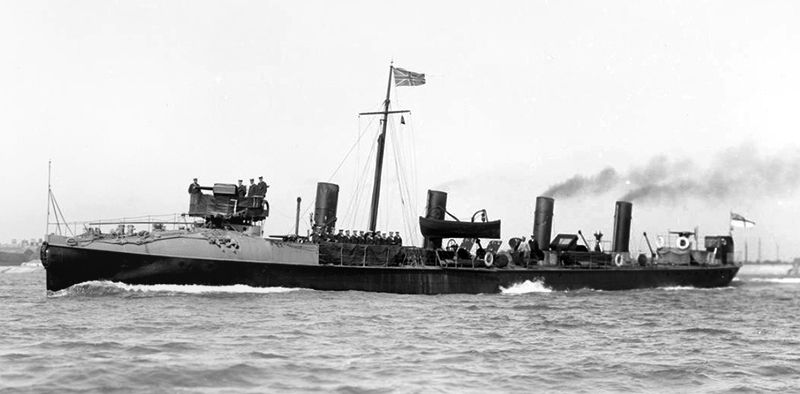
Whilst not specializing in building torpedo boats, Laird had already had some success in building torpedo vessels and were a logical choice to follow Thornycroft and Yarrow in laying down destroyers. They produced a four funnelled design with French-designed (Normand) boilers.
In 1900, both lost a 450mm TT and in 1902 for Lynx and in 1906 for Ferret their remaining tubes. They had instead two 57mm/40 6pdr Hotchkiss Mk I installed/
HMS Ferret was started 7.1893, launched 9.12.1893 and completed 3.1895, she was used as a test vessel 12.1908.
HMS Lynx was laid down on 7.1893, launched 24.1.1894, comp. 8.1895.
HMS Ferret served in the Devonport instructional flotilla, and by 1900 transferred to HMS Cambridge (gunnery ship) off Plymouth. She had boilers repaired in the Spring of 1902 and became tender to HMS Defiance at Devonport. She took part in the Coronation Review.
In 1907 Ferret was surveyed and found to be worn out, in December 1908 she was used in experiments, charging boom defences before being dismantled at Chatham in 1910. In 1911 she was sunk as a target.
On 26 December 1894, HMS Lynx ran aground off the coast of Cornwall. Damage was repaired in drydock and in July 1896, she took part in the Royal Navy’s annual manoeuvres. By June 1897 she was present at the Spithead Jubilee Fleet Review and on 30 September 1897, she ran aground in thick fog off Dodman Point, Cornwall. Refloated, she ws repaired in Devonport. There was a court martial, but her commanding officer was acquitted as she followed HMS Thrasher in her manoeuver that day.
Lynx served with the Devonport instructional flotilla. By February 1900 she became tender for HMS Defiance torpedo school, Devonport. In 1902 she was in the Channel Squadron and had new boiler tubes by May, by August, she took part in the Coronation Review.
However by February 1908 an inspection revealed that her deck plating and bulkheads were severely rusted. She was mothballed, but only sold for scrap on 10 April 1912.
Displacement: 300t standard, 350t fully loaded
Dimensions: 60.1m oa (59.4m pp) x 6.04 x 2.74m
Powerplant: 2 shafts 3-cyl VTE, 4 Normand boilers, 4,475 shp, 27.2 kts, coal 58t, 1,155nm/11 kts
Armament: 1x 76mm/40 12pdr 12cwt QF Mk I, 3x 57mm/40 6pdr Hotchkiss Mk I, 1x 450 TT (bow aw), 2x 450mm TT
Complement: 46
Active service
Modernizations:
The first six 26-knotters had an armament of three 450 mm TT or 18 inches torpedo tubes, between the fixed bow tube and two single deck tubes, plus a generous QF armament. But provision was made for landing the two deck tubes, replacing them by an extra 6-pdr (57mm) if used entirely for anti-torpedo boat work. It was done eventually, and they served all their career with an all-gun armament, better justifying their existence.
All these also had twin shafts, triple expansion engines, albeit only the Thornycroft boats had the special four cylinder triple expansion design that really innovated the type. HMS Havock was the also the only destroyer fitted with locomotive boilers, a well-tried installation, and she could therefore be completed before the others, becoming in effect the very first, British destroyer. She had only two funnels very close together. Upon insistence of Fisher her sister, HMS Hornet, also from Yarrow, tested for her part the water-tube boilers her craved for. She had four of them. During sea trials, all these boats reached and then went ahead of their intended admiralty speed of 26 knots. When the boilers were pushed harded and half-loaded, they all went above 27 knots.
In 1900 HMS Havock however was re-boilered with three Yarrow water-tube boilers (3800hp, 26kts) instead of four as on her sister. And she had one 450mm TT removed. Like the others, she had no spare torpedoes. In 1905, the same ship had her two remaining 450mm TT removed and in place were installed two single 6-pdr (57mm)/40 Hotchkiss Mk I. This was done on Hornet also.
in 1900, both Decoy and Daring had one 450mm TT removed and in 1905 HMS Daring like her sister lost her two remaining torpedo tubes and had two 6-pdr Hotchkiss Mk I installed at their place.
Service:
Decoy sank after collision with destroyer HMS Arun on 13 august 1904 off Wolf Rock. She was never recovered and stricken afterwards, the only loss of the 26-knotter class.
In 1907, Ferret was surveyed and found to be worn out. By December 1908 she was used for experiments, notaboy to charg boom defences to see if that kind of attack was practicable. She was eventually dismantled at Chatham in 1910 and the next year sunk as a target. HMS Lynx was also used for tests since 1902.
All in all:
Daring was sold for breaking up 10 April 1912.
Havock was sold for breaking up 14 May 1912.
Hornet was sold for breaking up 12 October 1909.
Ferret was dismantled in 1910, sunk as target by 1911.
Lynx was sold for breaking up 10 April 1912.
None was ever reclassified as “A class” therefore but in later publications and today’s naval literrature, making a distinguo between them and the 27 knotters.
General Assessment

A detailed cutaway of HMS Hornet, reddit.
Some 42 vessels constituted the “A” class, in two broadly similar orders, the 26 and the 27 knottes. They were constructed to individual own builder designs to meet Admiralty specifications, specifying a top speed of 26 and later (1893) 27 knots (50 km/h). The initial six shipe were differentiated by a slightly lower speed and differed in that to the following thirty-six vessels. Akk the surviving ships (none of the 26-knotters) were reclassified by the Admiralty for simplification as the “A class” in 1913, making a difference with the following named destroyers. Only a small numbers of the “27-knotters” were still active in 1914. They all greatly varied in funnels numbers, size and peculiarities, but all had the same “turtleback” forecastle, and were generally seen as very “wet” at their conning tower and command post.
They were also the first named “destroyers” short for “torpedo boat destroyers”, and in 1892, placed Britain at the forefront of this design. But it was not its invention as Spanish Vilaamil initiated the concept as a test in 1886 already and waters were already tried, not strickly speaking as such, with larger TBs than usual, wether they were called “high seas” or “division” boats. It’s really Britain that strictly speaking introduced the proper destroyer type, with a relatively large order to boot, denoting its will to make them operational (likely against France, later against Germany).
The 26 knotters were not very successful. Due to the fact little attention was paid on seaworhtiness, to the expense on speed, which was the main criteria, these boats were a bit too small to operate on all weather, albeite their speed, range and numerous QF guns made them ideal for their role. Neither were the following 30 and 33 knots. It’s really with the latter “special” types fitted for the first time with turbines, and next, the addition of a proper forecastle on the river class, that destroyers reached maturity, a few years before WWI broke out.
The Havock class not only was well observed round the world (The Spaniards ordered very similar ships with the Audaz class), but the design was copied outright faithfully by the Russian Imperial Navy which derived the Sokol-class destroyers from it, the very first Russian Destroyers. The British style also influenced the design in some ways of the Japanese Ikazuchi class, notably the armament.
The Havock class was also built by Yarrow for Argentina as the Corrientes class, launched 1896-97 (Corrientes, Misiones, Entre Ríos, Santa Fe).
Unlike their British counterparts, they served until 1930 but ARA Santa Fe, sunk in Uruguay by 1897.
Read More
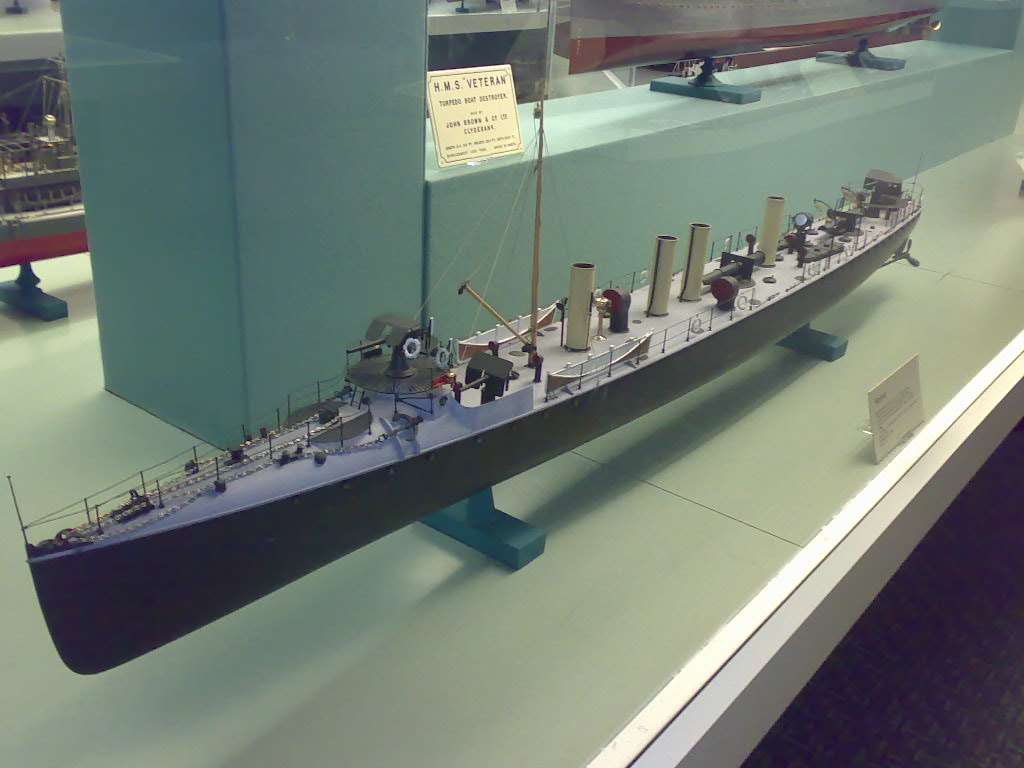
Another view of the HMS Hornet Model (CC)
Books
Chesneau, Roger & Kolesnik, Eugene M., eds. (1979) J.Gardiner Conway’s all the world fighting ships 1870-1905.
Colledge, J. J.; Warlow, Ben (2006) [1969]. Ships of the Royal Navy: Complete Record. Chatham Publishing.
Friedman, Norman (2009). British Destroyers. Barnsley, Seaforth Publishing.
Lyon, David (2001) [1996]. The First Destroyers. London: Caxton Editions.
Manning, T. D. (1961). The British Destroyer. Putnam & Co.
March, Edgar J. (1966). British Destroyers: A History of Development, 1892–1953. London: Seeley Service.
Brown, D. K. (2003). Warrior to Dreadnought: Warship Development 1860–1905. London: Caxton Editions.
Burt, R. A. (1986). Warships Illustrated No 7: British Destroyers in World War One. Arms & Armour Press.
Links
Early start
navypedia.org/ havock
navypedia.org daring
navypedia.org ferret
List on navypedia
A-class_destroyers
Havock-class_destroyer
https://en.wikipedia.org/wiki/Daring-class_destroyer_(1893)
Ferret-class_destroyer
http://www.navweaps.com/Weapons/WTBR_PreWWII.php
battleships-cruisers.co.uk: hms hornet
Model of the Havock on Bonhams, looking like the canvas beige for superstructures was replaced by blue green
A detailed rendition, 2D illustration
Model Kits
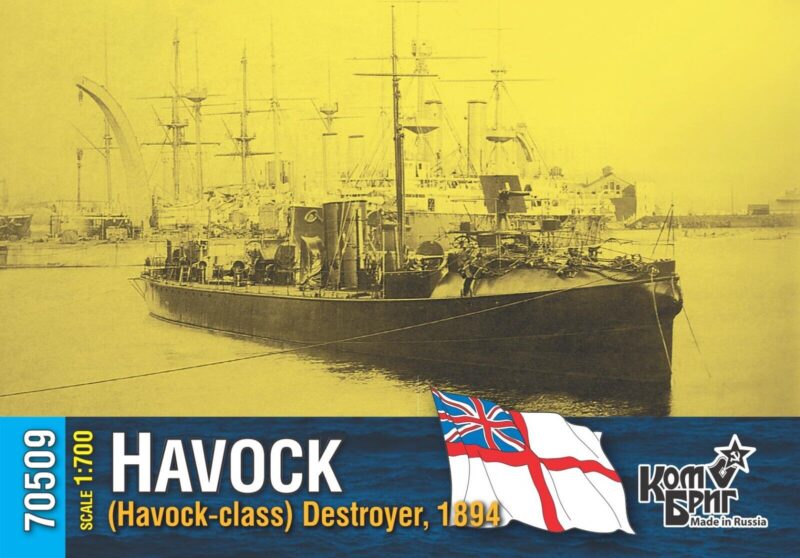
Kombrig’s 1:700 Havock in 1894, 78 mm long model.
There is also the HMS Hornet, same coll.
In fact Kombrig covered most WWI and 1890s classes of British destroyers in resin.

 Latest Facebook Entry -
Latest Facebook Entry -  X(Tweeter) Naval Encyclopedia's deck archive
X(Tweeter) Naval Encyclopedia's deck archive Instagram (@navalencyc)
Instagram (@navalencyc)





 French Navy
French Navy Royal Navy
Royal Navy Russian Navy
Russian Navy Armada Espanola
Armada Espanola Austrian Navy
Austrian Navy K.u.K. Kriegsmarine
K.u.K. Kriegsmarine Dansk Marine
Dansk Marine Nautiko Hellenon
Nautiko Hellenon Koninklije Marine 1870
Koninklije Marine 1870 Marinha do Brasil
Marinha do Brasil Osmanlı Donanması
Osmanlı Donanması Marina Do Peru
Marina Do Peru Marinha do Portugal
Marinha do Portugal Regia Marina 1870
Regia Marina 1870 Nihhon Kaigun 1870
Nihhon Kaigun 1870 Preußische Marine 1870
Preußische Marine 1870 Russkiy Flot 1870
Russkiy Flot 1870 Svenska marinen
Svenska marinen Søværnet
Søværnet Union Navy
Union Navy Confederate Navy
Confederate Navy Armada de Argentina
Armada de Argentina Imperial Chinese Navy
Imperial Chinese Navy Marinha do Portugal
Marinha do Portugal Mexico
Mexico Kaiserliche Marine
Kaiserliche Marine 1898 US Navy
1898 US Navy Sovietskiy Flot
Sovietskiy Flot Royal Canadian Navy
Royal Canadian Navy Royal Australian Navy
Royal Australian Navy RNZN Fleet
RNZN Fleet Chinese Navy 1937
Chinese Navy 1937 Kriegsmarine
Kriegsmarine Chilean Navy
Chilean Navy Danish Navy
Danish Navy Finnish Navy
Finnish Navy Hellenic Navy
Hellenic Navy Polish Navy
Polish Navy Romanian Navy
Romanian Navy Turkish Navy
Turkish Navy Royal Yugoslav Navy
Royal Yugoslav Navy Royal Thai Navy
Royal Thai Navy Minor Navies
Minor Navies Albania
Albania Austria
Austria Belgium
Belgium Columbia
Columbia Costa Rica
Costa Rica Cuba
Cuba Czechoslovakia
Czechoslovakia Dominican Republic
Dominican Republic Haiti
Haiti Hungary
Hungary Honduras
Honduras Estonia
Estonia Iceland
Iceland Eire
Eire Equador
Equador Iran
Iran Iraq
Iraq Latvia
Latvia Liberia
Liberia Lithuania
Lithuania Mandchukuo
Mandchukuo Morocco
Morocco Nicaragua
Nicaragua Persia
Persia San Salvador
San Salvador Sarawak
Sarawak Uruguay
Uruguay Venezuela
Venezuela Zanzibar
Zanzibar Warsaw Pact Navies
Warsaw Pact Navies Bulgaria
Bulgaria Hungary
Hungary

 Bundesmarine
Bundesmarine Dutch Navy
Dutch Navy Hellenic Navy
Hellenic Navy Marina Militare
Marina Militare Yugoslav Navy
Yugoslav Navy Chinese Navy
Chinese Navy Indian Navy
Indian Navy Indonesian Navy
Indonesian Navy JMSDF
JMSDF North Korean Navy
North Korean Navy Pakistani Navy
Pakistani Navy Philippines Navy
Philippines Navy ROKN
ROKN Rep. of Singapore Navy
Rep. of Singapore Navy Taiwanese Navy
Taiwanese Navy IDF Navy
IDF Navy Saudi Navy
Saudi Navy Royal New Zealand Navy
Royal New Zealand Navy Egyptian Navy
Egyptian Navy South African Navy
South African Navy






























 Ukrainian Navy
Ukrainian Navy dbodesign
dbodesign